Continued from the September 2012 Home Page. To go to an archived version of
that page click here:
November 2012 Home Page
Archive. To return to this
month's actual Home Page click on the Signal Corps
orange Home Page menu item in
the upper left corner of this page.

continuing...
Having said all of this, it must be recognized that the
Vietnamese central government’s approach to internal
policies that affect its ability to maintain regime security
within the country is different than what it will do and say
as it looks to broaden relations with external countries.
That is, how it treats its people on the subject of regime
security is one thing. How it treats countries like America
on this same topic (i.e. countries that may present some
risk to it) is another. Considering of course that this is
what interests us here, it’s necessary for us to understand
what Vietnam stands to gain and lose if we are to craft a
policy on our own part to interface more closely with them,
without making them think that we want to tell them how to
run their country.
Recognizing the duality of the need to interface and trade
with democratized western countries while avoiding their
attempts to influence Vietnam’s form of government, Vietnam
is conflicted. On one hand, closer relations with the US
will bring tangible economic and strategic benefits to the
country. As an example, it will get better access to western
capital, markets and technologies, while enjoying a better
means of balancing itself against the growing power of
China… thus creating a more peaceful and safe place for it
in the world. On the other, party officials are aware of and
wary of the ‘peaceful revolution’ schemes that the US is
known to plot to subvert socialist/communist led regimes.
While some in the U.S. may claim that no such programs
exists, it should be clearly understood that the world’s
dictatorships and socialist/communist governments
(benevolent or otherwise) wholly believe that such programs
are very real. Because of this, many have put in place
measures to counter any such efforts. When Russia recently
tossed out (October, 2012) the U.S. Agency For Economic
Development for involving itself in its internal government
affairs, Vietnam’s leaders went through a convulsive fit of
apoplexy, turning over every rock they could find looking
for hidden American programs that might do them ill.
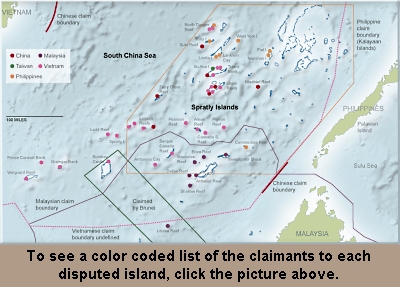 When
U.S. Congress or political leaders running for office
tout the need for countries like China to stop manipulating
their currency, or improve their human rights record as a
condition for stronger bilateral relations, all it does is
drive countries like Vietnam underground. Politically
motivated public statements that chastise those countries we
need most to improve our own ties with are of no value, and
only make America look like a bully of its own making.
Looking at this from Vietnam’s perspective, what one sees is
this: closer ties with the U.S. may help Vietnam maintain
ownership and control over some of the Paracel and Spratly
Islands it lays claim to, wresting them from China’s grasp,
but on the other hand, these same closer ties may undermine
the CPV’s own legitimacy inside its own country. Which is
worse? Losing an island to China, or your whole country to
the United States?
When
U.S. Congress or political leaders running for office
tout the need for countries like China to stop manipulating
their currency, or improve their human rights record as a
condition for stronger bilateral relations, all it does is
drive countries like Vietnam underground. Politically
motivated public statements that chastise those countries we
need most to improve our own ties with are of no value, and
only make America look like a bully of its own making.
Looking at this from Vietnam’s perspective, what one sees is
this: closer ties with the U.S. may help Vietnam maintain
ownership and control over some of the Paracel and Spratly
Islands it lays claim to, wresting them from China’s grasp,
but on the other hand, these same closer ties may undermine
the CPV’s own legitimacy inside its own country. Which is
worse? Losing an island to China, or your whole country to
the United States?
In forming our new military policies as regards engaging
more closely with Vietnam, these factors must be kept in
mind. From the Vietnamese’s perspective they are asking Why is America
coming back here? For what purpose? More importantly, never
mind what we will gain, what will we lose if we engage with
the U.S. again?
Which
Big Brother Is Safer: China or the US?
For most Americans it seems a matter of fact that Vietnam
and China are close friends, reflecting a brotherly
relationship stemming from the sharing of a common border
for thousands of years; whereas the relationship between
Vietnam and United States is one based on suspicion and
caution born of past differences. That is not the case. From
Vietnam’s perspective, both China and the U.S. are two peas
in the same pod.
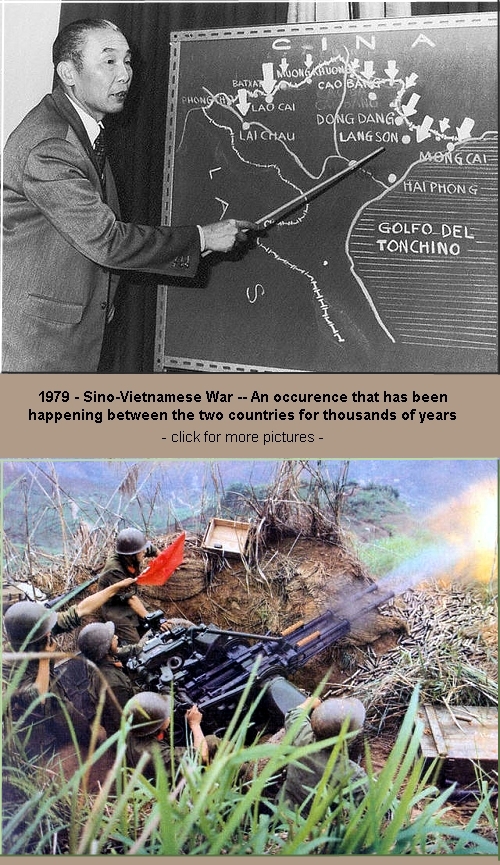 For
Vietnam, the U.S. is a dangerous country to liaise with,
notwithstanding the fact that it is located 8,500 miles away.
The same is true
for China though, except that since it is on Vietnam’s doorstep
this may make it even more dangerous for Vietnam to liaise
with than the U.S. In fact, many
Vietnamese feel that of the two China is much more
dangerous, having tried to subjugate Vietnam and make it a
vassal state ever since the Chinese general Zhao Tuo first
defeated the Vietnamese Emperor An Dương Vương in
207 BC. Since that date, Vietnamese leaders have been
fighting off repeated attempts by the Chinese to dominate
Vietnam. If truth be told, this long enduring enmity is what kept
Vietnam ‘in the closet’ for so many years after the
U.S.–Vietnam War was over.
For
Vietnam, the U.S. is a dangerous country to liaise with,
notwithstanding the fact that it is located 8,500 miles away.
The same is true
for China though, except that since it is on Vietnam’s doorstep
this may make it even more dangerous for Vietnam to liaise
with than the U.S. In fact, many
Vietnamese feel that of the two China is much more
dangerous, having tried to subjugate Vietnam and make it a
vassal state ever since the Chinese general Zhao Tuo first
defeated the Vietnamese Emperor An Dương Vương in
207 BC. Since that date, Vietnamese leaders have been
fighting off repeated attempts by the Chinese to dominate
Vietnam. If truth be told, this long enduring enmity is what kept
Vietnam ‘in the closet’ for so many years after the
U.S.–Vietnam War was over.
It wasn’t until Vietnam normalized relations with China in
the 1990s that Vietnam was able to break out of its
international diplomatic isolation and begin to work on
improving its own ties with the Association of Southeast
Asian Nations (ASEAN). Once relations with ASEAN
were returned to order, then Vietnam was able to put its
relations with the U.S. on a normal footing, from whence it
was then able to enjoy customary relations with all of the
remaining world powers. Lest this point of China dominating
Vietnam’s position on the world stage be missed, the reader
should recognize that for the first time since the socialist
republic came into being in 1945 Vietnam now enjoys global
acceptance, a event that could not happen without it
patching its relations with China and
kòu tóu -ing to China in the process.
What we can learn from this is that Vietnam learned a cruel
lesson when it took on China. Today still, bitter memories
of the 1980s and China’s efforts to subjugate and isolate
Vietnam from the world remain, with the result that the
Vietnamese do not want to repeat this experience. Therefore,
unless some other country (the U.S.?) is able to throw a
coat of protection over Vietnam’s shoulders… something that
insulates it completely from China’s pique, Vietnam is going
to go far out of its ways to maintain a peaceful and stable
relationship with China. The question is, does this intent
to maintain stable relations with China make the process one
of Vietnam’s top foreign policy priorities, or is the
priority to find someone with a big, enshrouding, warm and
safe coat in which to hide?
Part of the answer lies in whether Vietnam wants to continue
to pursue socialist economic management principles or not.
If so, then clearly the priority will trend towards China.
If not, then there is a big opening for the U.S. in
rebuilding both economic and military relations with
Vietnam. Economic, because that goes to the heart of what
Vietnam is seeking… a stable, growing economy that brings
independence from China to the country and a better quality
of life for its people… and military, because without the
U.S.’s military support Vietnam would soon find itself on
the losing end of the stick with China again.
It can be said then that ideological affinity between these
two purported socialist countries is either a major driving
force that keeps them together, or it is not. Considering
that with the collapse of the Soviet Union and Eastern
Europe the Chinese Communist Party (CCP) and the VCP are the
only two major communist parties in the world still in
power, one would think that they look to each other as soul
mates, working to provide mutual backing and encouragement
to each other.
This author would say that this is not so. In fact, while
they do hold periodic conferences to discuss ideological
theories that have come under threat because of the
basically capitalist infrastructure they are both putting in
place, and exchange experiences on issues such as party
cohesion and warding off ‘peaceful evolution,’ they both
know that their real need is to build closer ties with
countries like the U.S., so that they can learn from our own
failures as regards the free enterprise economic system and
what makes it tick. If we in the military focus on this,
then we will quickly see that what Vietnam covets are not
closer ties to China, per se, but closer ties to
the U.S.; and as we said above, in order to do that they are
going to need much closer ties to the U.S. military… as only
the U.S. military can protect Vietnam from China’s anger
when she recognizes that she has been replaced by the U.S.
as Vietnam’s number one son.
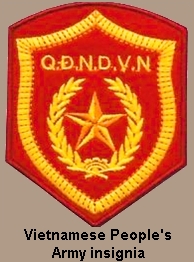 Imagine
that: America’s Army, this time in north Vietnam, fighting
alongside the Vietnam People's Army (VPA) (Vietnamese:
Quân Đội Nhân Dân Việt Nam) to stop an invasion from
China? I’ll bet you didn’t think you would see that in your
lifetime?
Imagine
that: America’s Army, this time in north Vietnam, fighting
alongside the Vietnam People's Army (VPA) (Vietnamese:
Quân Đội Nhân Dân Việt Nam) to stop an invasion from
China? I’ll bet you didn’t think you would see that in your
lifetime?
Critics might say this will never happen. Economic
interdependence between the two countries is growing, and
China is Vietnam’s biggest trading partner. Bilateral trade
turnover reached US$27 billion and accounted for 17% of
Vietnam’s total trade in 2010.
Yes, this is all true. But so is it true that while China is
beginning to become a consuming society that buys from the
rest of the world, the U.S. is already one, and has been the
world’s largest consuming society since the late 1890s. So
again, if you are Vietnam and need to develop a higher
degree of integration between your economy and that of
another, which would you pick: the one on your border trying
to take the islands you claim title to, and subjugate you in
the process, or the one 8,500
miles away that will a) help you protect your islands, b)
provide you with capital to build your economic
infrastructure, c) buy the goods that new economic
infrastructure manufactures, and d) protect you from that
bully to your north?
Add to this China’s unprecedented military buildup, its new
face showing signs of expansionism, continuing territorial
disputes between the two countries, and its past 3,000 year
aggressive history with respect to Vietnam, and it is easy
to see that Vietnam today sees this far more powerful China
as a most serious threat. It may be true that Vietnam cannot
today afford a more hostile relationship with China, but
then again it also cannot afford to sit back and do nothing,
possibly sacrificing its national sovereignty and
territorial integrity in the process. What Vietnam must do,
and everyone knows it, is reach out to a foreign partner,
building relations with it that will help it deter Chinese
aggression, and hopefully help build the Vietnamese economy
in the process.
Who better to do that with than the United States? More
accurately, what other country on earth would even consider
going to Vietnam’s rescue, possibly putting itself in the
line of Beijing’s fire in the process?
Only America.
Where Do We Stand Today?
For those unfamiliar with the current state of relations
between the U.S. and Vietnam, an effort to make it stronger is already
underway. After the normalization of relations between our
two countries in 1995, bilateral dealings advanced rapidly,
to such a point that today there are talks on both sides
about establishing a strategic partnership between the U.S.
and Vietnam. Economic ties, in particular, have deepened to
the extent that they provide a solid footing for even more
bilateral cooperation. Yet these economic ties could be
better. What is needed, as an example, is for the Vietnam
Vets that are now mature and running successful companies in
America to expand their operations into Vietnam. If they
did what they would find are welcoming hands and open arms,
from a people more curious about who these Americans are
that used to fight them, than anything else. Vietnam needs
American businesses to invest in it, and American business
needs to do so, if only to stem China’s rise and threats to
the U.S. on other fronts.
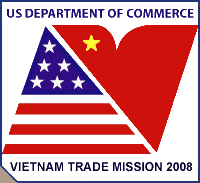 From
2001 to 2011 two-way trade between the U.S. and Vietnam
increased more than 12 times to US$21.8 billion, nearly
matching that of trade between Vietnam and China. More
important, the US is currently Vietnam’s biggest export
market, displacing China and accounting for nearly 1/5 of
Vietnam’s annual exports by value. In 2010 the U.S. became
Vietnam’s seventh largest foreign investor in the country.
From
2001 to 2011 two-way trade between the U.S. and Vietnam
increased more than 12 times to US$21.8 billion, nearly
matching that of trade between Vietnam and China. More
important, the US is currently Vietnam’s biggest export
market, displacing China and accounting for nearly 1/5 of
Vietnam’s annual exports by value. In 2010 the U.S. became
Vietnam’s seventh largest foreign investor in the country.
What does all of this tell us? One thing it says is that the
VCP is clearly willing to promote further ties with the
U.S., not only for economic value but for strategic reasons
too. Considering that this is undoubtedly in our own
economic and strategic interest, one thing we should guard
against is letting the public discussions about Vietnam’s
human right conditions grow out of control and undermine this
process.
Yes, America needs to champion human rights, but not to the
point that our talk of it undermines our ability to do
something about actually improving human rights, such as by
actually getting American’s into a country, working with its
people on a daily basis, and transferring our values to the
locals through deeds, as opposed to political talk and
tongue wagging on Capitol Hill. At the moment those in
Vietnam who fear the hegemony of U.S. imperialism are
watching closely for a ‘peaceful evolution’ scheme to be
launched against the VCP. And the avenue they think this
scheme will come down is labeled “human rights.”
In this regard, making the further
development of bilateral relations between our two countries
conditional on improvements in Vietnam’s human rights
record, as some U.S. politicians are calling for, would be a
grave mistake. All it would do is push Vietnam back into
China’s arms, where neither a net gain to America’s economic
or strategic values (as re. Vietnam) would take place, nor a
gain for those suffering from human rights abuse in Vietnam.
The answer is not to ratchet up the rhetoric about what’s
wrong with Vietnam, but to engage with it and quietly go
about demonstrating America’s values from within the
country.[1]
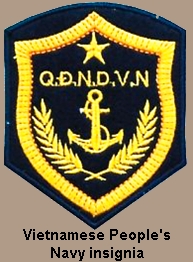 With a softly, softly approach to Vietnam’s human rights
issues the U.S. can expect to see greater flexibility as
regards Vietnam agreeing to be brought on board as a member
of the Co-security Sphere discussed in our earlier articles.
This most especially as the role the contested islands play
in Vietnam’s economy is significant. In 2010 the revenue
generated by Vietnam’s national oil and gas corporation (PetroVietnam)
accounted for 24% of the country’s GDP. Underlining the
importance of this, most of PetroVietnam’s revenue was
generated from operations in the South China Sea, in the
very area China is contesting.
With a softly, softly approach to Vietnam’s human rights
issues the U.S. can expect to see greater flexibility as
regards Vietnam agreeing to be brought on board as a member
of the Co-security Sphere discussed in our earlier articles.
This most especially as the role the contested islands play
in Vietnam’s economy is significant. In 2010 the revenue
generated by Vietnam’s national oil and gas corporation (PetroVietnam)
accounted for 24% of the country’s GDP. Underlining the
importance of this, most of PetroVietnam’s revenue was
generated from operations in the South China Sea, in the
very area China is contesting.
However, the benefits to be had from Vietnam’s territorial
waters extend far beyond oil and gas. Fishery industries,
tourism, maritime transportation, port services, and others
all factor into the matter. The VCP projects that by 2020
the marine economy could account for 53%–55% of GDP and
55%–60% of all exports. Thus, with oil and gas being tied to
ownership of this region of the Pacific, maritime
industries, and national security, Vietnam is sure to see
offers from America of help as a welcomed approach.
The fact is, China has long obstructed Vietnam’s economic
activities in the South China Sea. In addition to seizing
hundreds of Vietnamese fishing boats every year, China has
aggressively pressured Western oil and gas companies to
cancel their ventures in Vietnam’s exclusive economic zone
(EEZ). In a now legendary event in May 2011, a Chinese
marine surveillance ship harassed and then deliberately cut
the cables of a PetroVietnam survey vessel deep within what
should be considered Vietnam’s EEZ. The incident sparked a
wave of international criticism over China’s increasing
brazenness in the South China Sea, in favor of Vietnam.
With these things happening, there has never been a better
time for the U.S. military to extend its hand to the
Vietnamese military, to build a solid, mutually respectful,
and mutually beneficial relationship.
What Can America’s Army
Contribute To Vietnam’s?
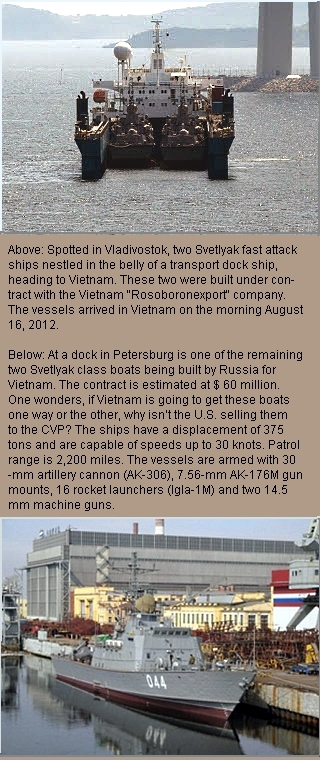 There is a massive gap in military strength between that of
Vietnam and China. Even so, Vietnam is uncompromisingly
working to develop capabilities to deter Chinese aggression.
First, it’s been speeding up its Navy’s military
modernization, doing so by upgrading naval capabilities by
acquiring modern Svetlyak class fast attack craft and
Gephard class frigates. It is also awaiting 6 Kilo class
submarines that will start being delivered in 2014, as well
as a series of Bastion land-based anti-ship cruise missiles,
all with extended range artillery munitions.
There is a massive gap in military strength between that of
Vietnam and China. Even so, Vietnam is uncompromisingly
working to develop capabilities to deter Chinese aggression.
First, it’s been speeding up its Navy’s military
modernization, doing so by upgrading naval capabilities by
acquiring modern Svetlyak class fast attack craft and
Gephard class frigates. It is also awaiting 6 Kilo class
submarines that will start being delivered in 2014, as well
as a series of Bastion land-based anti-ship cruise missiles,
all with extended range artillery munitions.
Recognizing that these are short term measures, Vietnam is
developing its own defense industry via both co-production
agreements with other countries, as well as by underwriting
technology transfers. On this latter point, Vietnam said it
is building Sigma class corvettes with help from the
Netherlands, as well as a series of patrol boats modeled on
the Svetlyak offshore patrol vessel.
Even considering these steps, Vietnam’s naval investment is
no match for that of China, and so it must find a larger
naval power to partner with. Enter the U.S. Navy. Behind all
of the rhetoric what one will see is that, although Vietnamese leaders are saying
that Vietnam will be self-reliant and never seek to enlist
foreign assistance in solving disputes with other countries,
it is actually making concrete efforts to reach out to
foreign powers as a counterweight to its substantial
defenselessness against China.
If this is the case with regard to its navy, then what of
its army? Surely, in any military confrontation between
Vietnam and China at sea, the Chinese are going to
supplement their naval actions with cross border attacks
too. Can Vietnam’s army stand up to China’s? One thinks not.
And
therein an opportunity for the U.S. Army to begin to develop
strategic relations with the Vietnamese military, just as
the U.S. Navy has done with Vietnam’s own Navy.
What can a relationship with the U.S. Army bring to Vietnam?
Part of the answer is that if Vietnam is to have a
relationship with the U.S. government then it needs to have
relationships with all of the elements that make up
our government, from the State Department to our Army and
Navy. It’s not a matter of the U.S. Army wanting a
relationship with Vietnam, it’s a matter of the Army having
to have one, in order to support the strategic goals America
has in this region of the world. Such goals should include
contributing to regional peace, security and prosperity, as
well as the further economic transformation and
international integration of Vietnam into the international
community, most especially the countries of the Asia–Pacific
region. In that regard, closer relations between the U.S.
Army and the Vietnam People’s Army will:
• Lay the groundwork for regional peace and security by
causing the VPA to engage in constructive participation in
the international and regional institutions (such as the
previously mentioned Co-security Sphere group) that promote
peacekeeping operations, both within and external to UN
frameworks.
• Help assure that the world and China in particular see
Vietnam not as a potential challenger to regional order and
stability, but as an independent, open and strong country
working to promote peace. For the other countries of
Southeast Asia a strong Vietnam is much preferred to one
that is weak, inward looking, and China dependent.
• Finally, the economic growth and international integration
of Vietnam will contribute to regional prosperity and
therein encourage the transformation of Vietnam into a more
open and democratic society, thus helping to change its
human rights stance over the long run. As all would agree,
international socialization causes countries to adopt
universal values, norms and standards, thus moving the
countries involved towards greater respect for the rights of
their own citizens.
US-Vietnam Defense Relations, The Road Forward
What is needed in all of this are a set of practical steps
designed to establish and carry out a program focused on
increased bilateral defense cooperation. Already some work
along this line is underway, but more must be done. One can
see both the good work that has been done to date by
looking, as an example, at Secretary of Defense Panetta’s
recent trip to Cam Ranh Bay. One can also see from this the
work that still needs to be done.
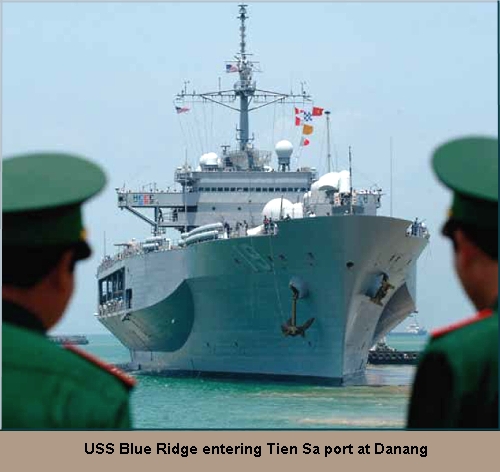 While
Panetta was there on board the USNS Richard Byrd, he wasn’t
there on a U.S. warship. At this stage the Vietnamese will
not allow U.S. warships to dock in Cam Ranh, only cargo
ships like the Byrd; ships operated by the Navy’s Military
Sealift Command, ones primarily manned by civilian crews. On
the other hand, U.S. Navy warships are allowed to dock in
Vietnam in the context of normal and routine naval
diplomacy, if they dock at Da Nang. The point being, while
inroads are being made, there is still a long way to go
before military-military relations are fully normalized.
While
Panetta was there on board the USNS Richard Byrd, he wasn’t
there on a U.S. warship. At this stage the Vietnamese will
not allow U.S. warships to dock in Cam Ranh, only cargo
ships like the Byrd; ships operated by the Navy’s Military
Sealift Command, ones primarily manned by civilian crews. On
the other hand, U.S. Navy warships are allowed to dock in
Vietnam in the context of normal and routine naval
diplomacy, if they dock at Da Nang. The point being, while
inroads are being made, there is still a long way to go
before military-military relations are fully normalized.
It’s not that the Vietnamese don’t want U.S. warships in Cam
Ranh, it’s that they are holding out this tidbit as a cherry
to be exchanged when we lift restrictions on the sale of
better arms to the Vietnamese military. What we should do is
complete this bargaining effort on their part: give them a
roadmap leading to better arms, including in it a schedule
for the release of the arms involved in a manner that
balances delivery of the arms with closer relations between
the branches of our military that govern use of the arms
involved. Thus, on the Navy’s side, bargain improvement in
naval arms for closer cooperation between the commanders of
our two navies, including joint training exercises in the
process. And the same for the Army; provide them with better
combat arms in return for joint training exercises that see
Vietnam’s army training at U.S. bases in America, in return
for our doing the same at bases within Vietnam.
What is needed is an across the board ambitious program of
cooperation between our two militaries, one that focuses
from our side on forging a closer defense partnership by
drawing the Vietnamese military into the Co-security Sphere
group.
Clearly, this will require flexibility and patience on our
part, along with a set of very capable senior Officers who
have the authority to move such a program forward. To be
managed by both U.S. Navy and Army Officers, these on the
ground military policy implementation specialists should be
fully familiar with not just the U.S. military's strategic
imperatives with regard to Vietnam, but also how our and
Vietnam's State Department works. They should have prior
experience in both foreign relations and nation building,
and be able to not just think outside of the box but work
outside of it too. The reason for this is that the
Vietnamese, while fearful of China, are relatively
comfortable with the existing level of activity in defense
relations between us. To overcome this reticence on their
part to expand relations we are going to need military
leaders that can show them that if such a closening of ties
takes place it will support and be congruent with Vietnam’s
own national interests. Basically we must show them that we
can do more than just help support their already stated
commitment to regional engagement as per the rules laid out
by ASEAN, improving on them by giving Vietnam more control
and influence over the entire process.
Some might say that these intentions are all well and good,
but what makes us think that Vietnam will work with our Army
as closely as we wish? Surprisingly, the answer is that they
already have. That is, the VPA has already demonstrated a
remarkable capacity to work closely with the U.S. Army when
they joined in solid fellowship with us in the late 1980s
and 1990s in conducting a series of successful joint field
activities to account for U.S. POWs and MIAs from the
Vietnam War. During these efforts both sides worked very
much in faithful consideration of each other’s needs to
increase the effectiveness of the planning and execution of
these joint efforts. The result was a decade of lessons
learned, on how to coordinate, communicate, enhance safety,
manage transportation, and otherwise support each other on
the basis of a host-nation, guest-nation relationship. All
one needs to do then is extend this early coming together to
today, to encompass a joint effort to stymie China’s
expansionist tendencies.
From a strategic imperative standpoint this means that the
U.S. Army should expand its effort to assure that each party
has a chance to educate and train the other on how it sees
and prefers to create a series of jointly tailored and
undertaken military programs that address (1) logistics,
services, transportation, and facilities support as may be
needed in countering China’s aggression; (2) means to
provide humanitarian response efforts to either civil unrest
or natural disaster incidents; (3) means to participate in
joint peacekeeping efforts; and (4) in the end, ways to work
together where each shares a responsibility in a pooled
mission that might be defined as an as yet unknown but
combined military operation.
Once this has been done, then the two militaries need to
operationalize the programs they jointly defined by
instituting bilateral communication, coordination, and
command exercises. This they must do by developing
operational contact that permits both sides to observe the
effects of command and control on the other, preferably by
allowing the Vietnamese to train at U.S. continental bases
and facilities, and the U.S. to train at VPA bases within
Vietnam.
To be fair, some of this has already been done, as in the
case of the late 1990s programs that saw U.S.–Vietnamese
defense relationships trying to move forward based on a
series of three activities: multilateral conferences and
seminars hosted by the U.S. Pacific Command (PACOM);
senior-level military visits; and practical bilateral
cooperation in areas such as search and rescue (SAR),
military medicine, environmental security, and de-mining.
Yet while a good start, we say again that the effort
undertaken falls short of what is needed. Further,
relationship building between our two militaries has not
progressed fast enough, and more attention must be given to
this matter. And while we do agree that there are many and
varied reasons for the failure to move the relationship any
further along, such as the U.S. congress getting involved by
requiring that every Vietnamese officer offered
cross-relations training in peacekeeping activities be
certified as not having been involved in previous human
rights violations, the fact still remains: today we face a
historic and once in a century opportunity to leverage
China’s aggression over the disputed islands to our benefit
with Vietnam. Politicians need to stand aside and let the
State Department and DoD do its work, building a new, long
term relationship with Vietnam… one that includes our two
militaries working together as closely as we do with
Australia or Japan, if not closer. There is no reason why
this past enemy should not become a future close friend.
The bottom line: good progress has been
made, but much more needs to be done. For example, in
mid-2011 Vietnam enrolled the first VPA officer in our
National War College. Senior Colonel Hà Thành Chung,
a department head in the Vietnamese Military Science
Academy, joined the class of 2011–2012 for a year of study
as an International Fellow. Similarly, on September 20,
2011, the U.S.’ Deputy Assistant Secretary of Defense for
South and Southeast Asia and Vietnam’s Deputy Defense
Minister signed an MOU aimed at “advancing bilateral defense
cooperation.” The document identified five areas that both
sides will work to expand cooperation on: (1) maritime
security, (2) search and rescue, (3) United Nations
Peacekeeping Operations (UNPKO), (4) humanitarian and
disaster relief (HADR), and (5) collaboration between
defense universities and research institutes.[2]
To do this though the U.S. will need to see and understand
that the Vietnamese do not presently view deeper military
relations with the U.S. as a zero-sum game relating to
China. They feel that engaging more with the U.S. should not
necessarily necessitate engaging less with China. From this
one can see that Vietnam is comfortable with a foreign
policy that offers many options in the face of Chinese
assertiveness, and will likely continue to prefer such until it is
burned in a hot, at-sea exchange of fire with China—one that
eventually ebbs not because of China’s ability to control
its trigger finger, but because of the presence of U.S.
warships over the horizon. At that time the Vietnamese will
recognize the critical importance of an effective, friendly
relationship with the U.S., one deeper than that which
exists at this time.
Until that day comes, the U.S. military should continue to
push for these tactical objectives:
• Develop ways to assure better communication at all levels of both
militaries. In this regard the U.S. should push for increased training at
continental U.S. bases of VPA staff in planning,
communication and coordination in inter-military roles that
relate to missions involving civil and natural disasters, to
be followed with joint military missions relating to
peacekeeping and territorial protection.
• Expand the above programs to include additional training
in 1) logistics, services, transportation, and facilities
support; 2) evacuation and sheltering of displaced
populations during civil and natural disasters; 3) the roles
and missions of peacekeeping forces; and 4) roles, missions,
and responsibilities of the military in international
combined military efforts.
• As a first step towards causing Vietnam to join as a
member of the Co-security Sphere group, the U.S. should urge
Vietnam to become a joint member of a regional
search-and-rescue group. This will help migrate the
relationship from simple information sharing to involvement
in actual command exercises.
• Training should be supplemented with inclusion in joint
exercises with Japan, South Korea, Taiwan and the
Philippines, where command and operations, strategic
communications, coordination and support can be demonstrated
to the VPA, even though they may have no formal
military-to-military relations with these other countries in these
specific
areas. This will show the willingness of all of the
countries of South and Southeast Asia to bring Vietnam into
their realm of cooperation with the U.S.
• Reluctant or not, continue to place pressure on Vietnam to
participate in or at a minimum monitor force exercises on
the ground, offering them both learning objectives and
training modules that they can inernalize at their leisure.
• Being that in 2005 Vietnam signed an agreement with the
U.S. to participate in the International Military Education
and Training (IMET) program (for non-lethal areas), the U.S.
should carefully press the Vietnamese to expand the course
structure from military medicine, science and technology to
include a few modest military training team (MTT) subjects
such as might be useful in a joint exercise in territorial
protection... exercises such as those that might be needed
to keep China from gobbling up one of Vietnam's islands.
• And as Vietnam makes progress in these areas, the U.S.
should reduce barriers that exist to Vietnam participating
in lethal arms purchases from the U.S., allowing it to
participate as others do in the U.S.’ foreign military sales
(FMS) program in ways that ultimately enhance the
U.S.–Vietnam strategic relationship.
In our view, if the goal is to build strong and lasting
relationships with the middle power countries of Asia,
relationships that can help the U.S. counter China’s
increasing military aggression, then with respect to Vietnam
these are the types of initiatives that the U.S. Department
of Defense should pursue. They will contribute to a better,
closer, more sound, and longer lasting series of bilateral
military engagements, engagements of a type that will build
trust between the U.S. and Vietnamese military.
- - - -
Next month: Strategic Military Imperatives – Our
Conclusions Regarding Strategic Imperatives for Asia.


Footnotes
[1] The US has already taken a number of actions, not all
of which are conducive to improved relations with Vietnam. One involves an
annual review of the human rights situation in Vietnam, and includes calls
for interventions with Vietnamese authorities to get a number of political
dissidents released from detention. Additionally, a bill that seeks to link
US aid with Vietnam’s human rights record has been passed by the House of
Representative several times, but has never made it through the Senate.
Hopefully, cooler heads will prevail and recognize that these forms of
“engagement” have failed to work in the past, and considering how critical
it is that the U.S. find a way to thwart China’s expansionist tendencies, it
may just be that human rights needs in Vietnam should not be prioritized
above the U.S. gaining a) more thorough access to the country, and b)
establishing for the U.S. strategic abilities to counter China from within
Vietnam’s borders.
- To return to your place in
the text click here:

[2] Merle Pribbenow and Lewis M. Stern, “Notes on Senior
Colonel Hà Thành Chung,” prepared for the National Defense University, March
24, 2011.
- To return to your place in
the text click here:

Additional Sources
Carlyle A Thayer and Ramses Amer, Vietnamese foreign policy in transition,
St Martin’s Press, New York, 1999.
X Linh and T Chung, ‘Mỹ Muốn Việt Nam Cải Cách Doanh Nghiệp Nhà Nước’ [US calls
for reform of Vietnam’s state-owned enterprises], Vietnamnet, 24 February
2012.
Nicholas Khoo, Collateral damage: Sino-Soviet rivalry and the termination of
the Sino-Vietnamese alliance, Columbia University Press, New York, 2011.
Vietnam News Agency, ‘Mỹ Muốn Nâng Tầm Quan Hệ Đối Tác Chiến Lược Với Việt Nam’ [US wishes to promote strategic
partnership with Vietnam], Vietnamplus,11 November 2011.
Le Hong Hiep, ‘Vietnam eyes middle powers’, The
Diplomat, 5 March 2012.
Various additional writings of Mr. Le Hong Hiep: Mr.
Le Hong Hiep is a lecturer in the Faculty of International Relations,
Vietnam National University, Ho Chi Minh City, and a PhD candidate in
Politics at the University of New South Wales, Australian Defence Force
Academy, Canberra. Before joining the VNU, Mr. Le worked for the Ministry of
Foreign Affairs of Vietnam from 2004 to 2006. His articles and analyses have
been published in The Diplomat, East Asia Forum, BBC and Vietnamnet.
"Vietnam’s strategic trajectory: From internal
development to external engagement;" Strategic Insights, Australia Strategic
Policy Institute.
Credit for many of the bullet point viewpoints
expressed herein belong with Colonel (R) William H. Jordan. Col. Jordan
served as a Northeast Asia Foreign Area Officer from 1979 to 1997. He was
the Principal Advisor to the Secretary of Defense on POW/MIA Affairs from
1990 to 1993, and subsequently commanded the U.S. Army Central
Identification Laboratory in Hawaii.
Additional credit for concepts expressed here is due
Mr. Walter Lohman, Director of the Asian Studies Center at The Heritage
Foundation.
Lewis M. Stern, “National Defense University:
Building Strategic Relations with Vietnam,” Joint Forces Quarterly, April
2012.
Have a comment on this article? Send it to us. If you
are a member of the Association we will gladly publish it. If you are not,
well, it only costs $30.00 a year to become a member and have your views
heard... and because we are a fully compliant non-profit organization your
payment is tax deductable. If you would rather not become a member a $30.00
donation to our
Scholarship Fund will accomplish the same, and we
will gladly publish your views on this article.

